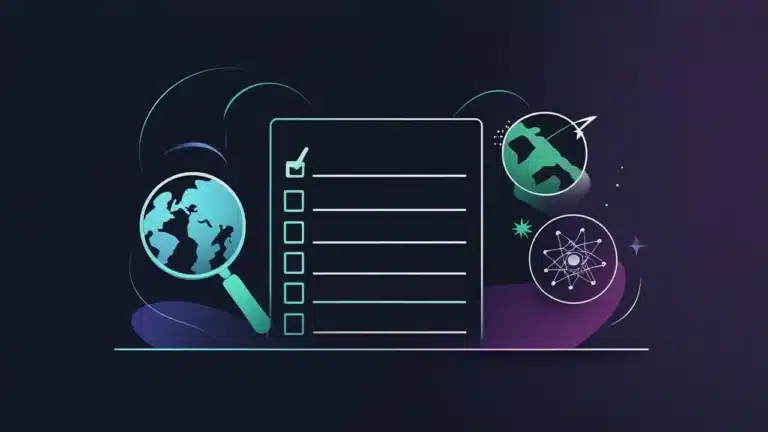Looking to write SEO titles and meta descriptions that will get more clicks to your website in 2025 and beyond? Read on to learn exactly how.
When optimizing your website for search engine visibility, one of the cornerstone elements of SEO is your meta information, which includes your title tag and meta description
“Meta” simply means “about or underneath”. This meta information comes in the form of meta tags, or snippets of code that you include within your site. There are two primary meta tags that matter for SEO, the title tag and meta description.
The title tag and meta description (otherwise known as the “SEO title” and “SEO description”) inform Google and other search engines about what the topic of your website is about. This information also shows up in the search results for users to see, and optimizing it can help them click through to your site.
If you’ve been wondering how to write your title tags and meta descriptions for better search visibility and click-through rates in the new generative AI era, you’ve come to the right place.
Creating SEO titles and meta descriptions that get more clicks requires a two-fold approach. First, you need to understand the technical nitty-gritty and best practices that make the search engines happy.
Second, you need to actually craft clickable copy that your audience wants to read.
We’re going to dive into both of these topics, so you understand how to tactically approach SEO titles and meta descriptions from an angle that makes both the search engines and your searchers happy.
SEO Title Tag Best Practices
You already know that a well written title tag is worth its weight in gold.
But how do you get the most out of these pesky little tags on your own site?
Great question.
Let’s dive into the mechanics of what it is and how to properly optimize it.
What is an SEO Title Tag?
An SEO title tag is an HTML element that defines the clickable headline in search results. It helps search engines and users understand a webpage’s content. Title tags influence rankings, click-through rates (CTR), and discoverability, making them one of the most important on-page SEO factors.
This information is present in the SERPS as the blue text at the top of every organic result.
Here’s an example of a title tag using our own website:

Now that you have the definition down, let’s talk about keywords.
Even though its ranking relevance has declined in recent years, the meta title tag is still important in determining how a page on your website is going to rank.
How To Structure and Format Your SEO title
- Each page needs to have a unique target keyword, or multiple target keywords (two to three typically the max). Two pages targeting the same group of or similar keywords (keywords in the SEO title, h1, etc) run the risk of splitting traffic and diluting the ranking for the correct page.
- The homepage should always target the main / hardest to rank keyword in title tag and description. This is especially true for new sites, but in general, the homepage will have the highest PA (Page Authority) and will likely have the best opportunity to rank for your top level business keyword.
- Place the primary keyword as far left in the tag as possible. Google has stated that they give slightly more weight to the first term in any given tag or phrase. Humans also read this way so will notice their target keyword first
How To Write Title Tags That Get Clicked
Not only is it important to understand what kind of content makes for a good title tag, but it’s equally as important to understand how to arrange this content so that it will be both search engine and user friendly.
Here are the best practices in 2025:
- Google will display up to about 60 characters. If you include more than that amount, you will run the risk of your title being cut off and only certain parts being shown to users. It’s important to test this in with tools such as the SERP preview tool to make sure the title is appearing as you want it.
- Pipes and hyphens. These two symbols ( | vs – ), are each easily read and understood by Google, but hyphens technically take up slightly more space. Google’s crawlers and other bots treat them as a break, or a pause when reading the tag. In general, using pipes is the way to go because they help break up the text and make the title easier to read at a glance.
- Include relevant modifiers and secondary keywords in the tag as well. You have the opportunity to let Google know the page is focused on a broader concept, not only a single keyword or phrase. When inserting these long tail and primary keywords, remember to use natural language that humans will understand. Don’t insert keywords in any way or in a quantity that doesn’t make sense.
- When possible, do not forget to optimize any title or meta description on your site. Be sure to fill out the title and description tags for every webpage on your website. Failing to do so makes your web page content look less unique (the Goog doesn’t like this).
- Write quality titles – not just ones that follow the formula. Simply including your keyword in a generic 60-character title might not do the trick. Google these days also prioritizes quality and the user experience, and people should actually want to click your titles if they rank. Instead of just producing the same ole’ titles over and over, push yourself and your team to be clever and enticing.
Good SEO Title Examples
B2B SEO Strategy in 2024: A Complete Guide for SaaS Companies
– Uses a primary keyword early, is descriptive, and has a clear value proposition.
What Is Demand Generation? The Ultimate Guide for B2B Marketers
– Clearly addresses search intent and includes a common question format that users search for.
Best CRM Software for Small Businesses (2024 Comparison & Reviews)
– Uses “Best” to imply authority, adds a specific year for freshness, and targets a comparison-based intent.
Bad SEO Title Examples
SEO Titles and Meta Descriptions | RevenueZen
– No keyword specificity, generic, and unenticing for users to click.
Home – Our Blog About Digital Marketing
– Wasted space with “Home,” no indication of what the page is about, and lacks a compelling reason to click.
SEO | Tips & Tricks
– Too vague, lacks keywords, and doesn’t signal authority or search intent.
Company Name vs Geography
A question that you will face eventually is whether or not to place your company name or a geographic modifier inside of your title and meta description tags.
The answer to that question depends on a few different factors and is largely dependent on what your specific strategy is.
Let’s take a look at a few different scenarios.
When to use a company name?
A good rule of thumb when to use your company name in the title tag is If there is large enough search volume to justify including it. That means that you have a relatively large brand presence and enough people are searching for it on a monthly basis.
The homepage is also an excellent situation to utilize this. Since users are inevitably going to be searching for your brand, and the homepage is often the most discovered landing page for any given site, having users see your brand name right away is greatly beneficial. This is especially true in the beginning of a project if it isn’t ranking well for its own brand, and will gradually help build brand awareness.
A few other places to include your company name are on the about, contact, and events pages. These are pages directly tied to understanding and communicating with the brand in any way.
When to use a geo?
In general, including a specific geography is used when you’re optimizing for clients that operate on a local level. When a service or product is localized, including geo in the title sends a signal to Google that what you’re offering is best for that particular area.
Meta Description Best Practices
Now that you got your hands dirty with those excellent title tags, it’s time to move on to the meta description.
Before you work on optimizing the tag, it’s best to understand what it is and why it’s important as well.
What is an SEO Meta Description?
An SEO meta description is an HTML tag that provides a brief summary of a webpage’s content. It appears in search results below the title tag and influences click-through rates (CTR). While it does not directly impact rankings, a well-written meta description can make search listings more compelling.
These tags are seen by users and can either help persuade or dissuade them from clicking on your link and going to your site.
Here’s an example of a meta description using our own website:

Despite no longer a direct ranking factor, but they still hold a good amount of indirect ranking importance.
Here are the best practices in 2025:
How To Write Meta Descriptions That Get Clicked
- Use the entire space. Google allows you to include up to 150 characters in your meta description so use the full amount.
- Include brand, primary keyword (and a secondary keyword if possible), target geo, and a call to action. These elements will all be bolded in the SERPS if a user types in a query that contains them. When a user sees this, they are more likely to feel like the result will satisfy their intent.
- Think of it as a mini advertisement for your brand. You are trying to promote your brand and web page. Write it in a way that will draw users in and cause them to want to click.
- Google can ignore this. Unfortunately, if Google feels that there is some other piece of information on the web page that better suits the user, they will look past your meta description tag and use that more relevant snippet instead. That’s why it’s good to give this information a good amount of thought beforehand. It’s also helpful to experiment in real time by seeing how your pages look in the SERPS.
- Make it compelling and in context for. You’ve got to tailor the description for your target audience so the message will resonate more closely with them. Consider what level of expertise your brand provides services to, what industry they are in, and what the intent is behind their target query.
Good Meta Description Examples
Struggling to get clicks from Google? Learn how to craft SEO title tags and meta descriptions that improve rankings and boost CTR.
– Highlights a problem, solution, and outcome while including relevant keywords like “SEO title tags” and “meta descriptions.”
Looking for the best CRM software in 2024? We analyzed the top options based on features, pricing, and ease of use—see our recommendations.
– Engages the user with a question, provides value, and sets expectations about the content.
Want more organic leads? Discover the latest B2B SEO strategies that drive traffic and revenue with our expert-backed guide.
– Uses a question to hook the reader, includes keywords naturally, and emphasizes a benefit.
Bad Meta Description Examples
We provide digital marketing services and SEO tips. Read our blog to learn more.
– Too generic, lacks any compelling reason to click, and doesn’t highlight search intent.
Page about CRM software, including reviews and comparisons.
– Reads like filler text, lacks engagement, and doesn’t tell the reader why this page is valuable.
Find out more about our company and what we do. Click here to learn more!
– No keyword relevance, too vague, and includes a redundant “Click here” call to action.
What Else Matters Besides SEO Best-Practices?
When it comes to actually getting more clicks on your pages, what could matter more than SEO best practices? As it turns out, there are a few other things that matter to the humans doing the clicking, which influence if they wind up on your page or not.
Tying in Search Intent
Search intent refers to why someone is typing a specific query into Google, and it plays an important role in the content creation process. That’s because understanding search intent allows you to create content that meets your audience where they actually are, and which they’ll actually find useful.
Prospects typically experience search intent in different stages:
- Informational: Your customer is conducting initial rounds of research and learning the basics.
- Navigational: Your customer is using specific queries to end up on a certain webpage (such as searching “RevenueZen blog”).
- Commercial: When someone wants to know more about brands, products, or service. Typically a “bottom of the funnel” query.
- Transactional: This is when someone is actually ready to buy something.
Just as content should be created with search intent in mind, so should title tags and meta descriptions.
For example, if a piece of content is designed to meet customers at the informational stage of search intent, the meta description should be as well.
What About the Buyer’s Journey?
It’s not just search intent that matters – the buyer’s journey also plays an important role in your customers, and therefore your content. The buyer’s journey represents the stages that prospects experience in order to purchase something from your company. Taking it into consideration when it comes to your title tags and meta descriptions can help ensure these valuable pieces of text real estate are tangibly solving pain points, and leading to more conversions.
The buyer’s journey typically s broken down into three different stages:
- Awareness: This is the first stage of your buyer’s journey, where your customer first becomes aware that they have a pain point that they want to solve. They likely don’t know what that solution looks like.
- Consideration: During the consideration stage, your prospects are digging into research, looking into potential solutions to their pain point.
- Decision: Lastly, prospects arrive at the decision stage, where they select the solution to their pain point, whether it’s a product or service.
What are examples of titles that represent different stages of the buyer’s journey? Here are two samples from our own blog:
- How to Do B2B Cold Emailing Rightis an example of a pieceof content (and title) that is designed for a prospect in the awareness stage. You can see that this is an “introductory” topic that helps someone understand that they might need a solution to their pain point (B2B cold emailing).
- 6 Top-Tier Enterprise SEO Companies You Should Know Aboutis an example of a piece of content (and title) that is designed for a prospect in the decision stage. You can see how this would ideally lead to a purchase.
Are Title Tags and Meta Descriptions Ranking Factors?
Despite having a weakened direct influence on rankings in the last handful of years, the title tag and meta description tag are not dead.
They simply matter in a different capacity going forward. Primarily in terms of user engagement.
Let’s take a look.
CTR (click through rate) matters. Engagement matters. In recent years, Google has started placing more and more importance on how many people click on a result vs how often it’s seen. Optimizing these elements increases perceived relevance by users and will help lead to more clicks.
The title tag is still a ranking factor. According to Moz’s latest research, Title tags are “the second most important on-page factor for SEO”. With that being said, title tags are no longer as primarily effective as they once were, and spamming keywords into the title will likely yield no positive results.
Meta description is not a direct ranking factor, but can indirectly lead to higher search visibility through increased engagement.
User Experience. People will relate the SERP results they see as a direct reflection of your brand. Then, while they are making a decision about which company’s results they want to select, that will be part of their decision-making process. Your page content might be awesome, but these elements are what let searchers know first.
All in all, taking the time to get both your title tag and meta description dialed in should yield great results for your content.
Be sure to review your analytics after implementation and test regularly as well as setting up an SEO reporting system that makes sense for where you’re at in your SEO journey.
With that in mind, let us know if you’d like some expert help with content review and optimization.
Or, if you’re looking for some broader SEO strategy, get in touch for a free SEO opportunities roadmap. If you’re a startup looking for SEO help, we’ve got you covered too.
Happy optimizing.




